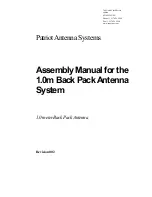
MFJ-1754 Dual Band Antenna
Instructions
2
During assembly of this antenna refer to the figures in this manual and the picture on page 1.
After the antenna is assembled it must be checked and adjusted for resonant frequency and SWR.
NOTE:
Wear safety glasses whenever working near or on this antenna
STEP BY STEP PROCEDURE
1- Insert a 6-32 x 1/2" screws through hole #1 with thread toward the inside of the chassis. Start a 3/8" nut on the tip
of this screw (
see Figure 1
).
2- Install the remaining two 6-32 x 1/2" screws and 3/8" nuts into hole #2 and hole #3 as was done in step 1
3- Insert a radial into hole A, straight end first (
see figure 2
). Sandwich the hooked end of radial between the chassis
and the 3/8" nut of the screw in hole #1. Secure the radial by tightening the 6-32 screw .
4- Install the remaining radials in the same manner. One radial should be inserted through hole B and secured with
screw in hole #2, the other through hole C and secured with screw in hole #3.
5- Assemble the U-Clamp in the chassis as shown in figure 2.
6- The antenna assembly is completed now. Antenna can be tested for frequency and SWR using an analyzer or a
transceiver on low power, then fine tuned before mounting it on a permanent location.
TUNING THE ANTENNA
The antenna is pre-tuned for low SWR on both the 2 meter and the 440 MHz bands. However, the SWR can change
from location to an other. In this case some minor adjustment is perhaps necessary.
Adjustment on this antenna in done by losing the set screw (
see figure 1
) and increase or decrease the length of the
radiator element to lower or increase the frequency respectively.
If a high frequency is desired and can not be obtained at the minimum setting of radiator length. Approximately 1/4
inch off the radiator bottom end can be cut to increase the frequency resonance of the antenna.
If the SWR of the antenna can not be adjusted using the radiator, it is possible to slightly bend the radials (only a few
degrees) up or down, one at a time to achieve a minimum SWR.
MAINTENANCE
MFJ-1754 is constructed of heavy duty non corrosive materials (aluminum and stainless steel hardware) and should
withstand normal climates for many years. The use of some type of coaxial connector moister protections
recommended at the coax connection, especially in coastal areas where salty mist is common.
GE makes "
SILICON DIELECTRIC COMPOUND
" which are good material for this application.
TECHNICAL ASSISTANCE
If you have any problem with this unit first check the appropriate section of this manual.






















